ADAPTIVE CRUISE CONTROL
When traffic conditions permit (large free-flowing road or motorway), the adaptive cruise control gives you the option of maintaining a chosen speed, known as the cruising speed, which can be set from 31 mph to 87 mph (50 and 140 km/h), or 93 mph (150 km/h) depending on the vehicle, while keeping a following distance from the vehicle in front in the same lane.
The sensor has a range of 120 metres.
Note: The driver should take into account the maximum speed limit in the country where they are driving.
Note: the adaptive cruise control can brake the vehicle up to a third of the braking capacity. Depending on the situation, the driver may need to brake harder.
This function is an additional driving aid. This function does not take the place of the driver.
Therefore, it can under no circumstances replace the driver’s responsibility to respect speed limits and to be vigilant (the driver must always be ready to brake).
The adaptive cruise control should not be used in heavy traffic, on winding or slippery roads (black ice, aquaplaning, gravel) and during bad weather (fog, rain, side winds etc.).
There is a risk of accidents.
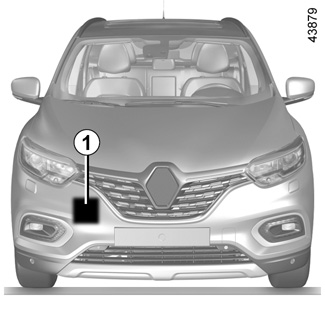
Sensor location
Make sure that the sensor 1 is not obscured (by dirt, mud, snow, etc.).
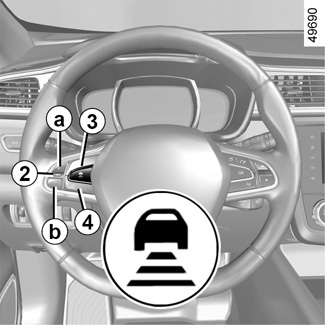

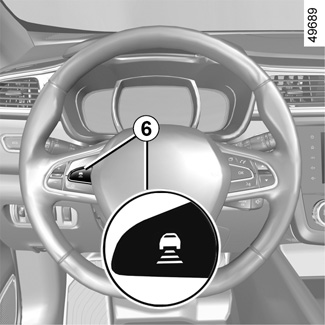
Controls
5 Main “On/Off” switch.
2 Controls for:
- a cruising speed activation, storage and increase (+);
- b decreasing cruising speed (-).
3 Activation with recall of saved cruising speed (R).
4 Switch the function to standby (with cruising speed saved) (O).
6 Adjusting following distance.
Switching on
Press switch 5. Indicator light comes on, lit green, and the message “Adaptive cruise ctrl” appears on the instrument panel, accompanied by dashes to indicate that the cruise control function is activated and waiting to store a cruising speed.
Activating cruise control
At a steady speed (above approximately 31 mph (50 km/h)), press the switch 2 on the a (+) side: the function is activated and the current speed is stored.
The cruising speed replaces the dashes and cruise control is confirmed by the appearance of the message “Adaptive cruise ctrl” and the warning light . If you try to activate the function while driving below around 31 mph (50 km/h) or above around 87 mph (140 km/h) or 93 mph (150 km/h) on some vehicles, the message “Invalid speed” is displayed and the function will remain inactive.
Adjusting the following distance
Pressing switch 6 multiple times adjusts the following distance.
Driving
Once a cruising speed is memorised and the cruise control function is active, you may lift your foot off the accelerator pedal.
If a following distance is stored and a vehicle travelling slower than yours is detected by the system in your lane, your vehicle will brake (with the brake lights on) and adapt its speed to that of the vehicle in front, respecting the following distance selected previously.
Overtaking
If your speed is lower than the cruise control and you wish to perform an overtaking manoeuvre, activating the direction indicator will provide acceleration enabling the overtaking manoeuvre.
Please note that you must keep your feet close to the pedals in order to react in an emergency.
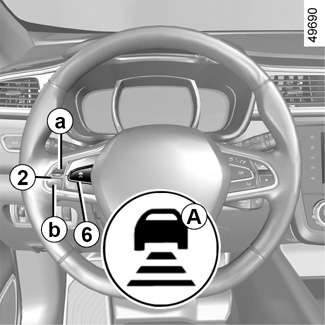
Adjusting the cruising speed
The cruising speed can be changed by pressing the switch 2 repeatedly:
- side a (+) to increase the speed;
- side b (-) to reduce the speed.
Varying the following distance
You can vary the following distance from the vehicle in front at any time by pressing switch 6 repeatedly.
Horizontal following bars will be displayed on the instrument panel, indicating the following distance selected:
- one bar for a short distance (corresponding to a following time of around one second);
- two bars for a medium distance;
- three bars for a long distance (corresponding to a following time of around two seconds).
Choosing the distance should depend on the traffic, the laws in your country, and on the weather conditions.
If a vehicle is detected by the system in your lane, an outline A of a vehicle will appear above the following bars.
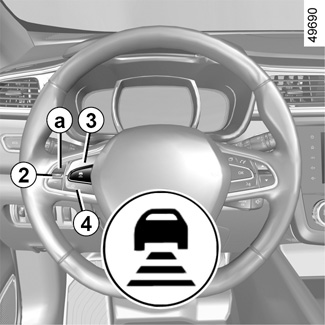
Exceeding the cruising speed
The cruising speed may be exceeded at any time by depressing the accelerator pedal.
When exceeding this speed, the cruising speed and the following bars show red and the cruising speed flashes on the instrument panel: the distance control function is no longer activated.
Then, release the accelerator: cruise and distance control will automatically reactivate unless the function has been set to standby.
Putting the function on standby
The function is set to standby if:
- you press switch 4 (O);
- you depress the brake pedal;
- you depress the clutch pedal;
- you use the gear lever;
- the vehicle speed is lower than 25 mph (40 km/h) or over 100 mph (160 km/h);
- certain driver correction devices and aids are triggered (ABS, ESC, etc.)
In the latter two cases, the message “Adaptive cruise ct disconnected” is displayed on the instrument panel when the function is set to standby.
Standby is confirmed by the display of the cruising speed in grey and the message “Adaptive cruise ctrl”.
Returning to the cruising speed
If a speed is stored, it can be recalled, once you are sure that the road conditions are suitable (traffic, road surface, weather conditions, etc.). Press switch 3 (R) if the vehicle speed is above around 30 mph (50 km/h).
When the stored speed is recalled, activation of the cruise control is confirmed by the illumination of the cruising speed in green, along with the message “Adaptive cruise ctrl”.
When the cruise control is set to standby, pressing switch 2 side a (+) reactivates the cruise control function without taking into account the stored speed - it is the speed at which the vehicle is moving that is taken into account.
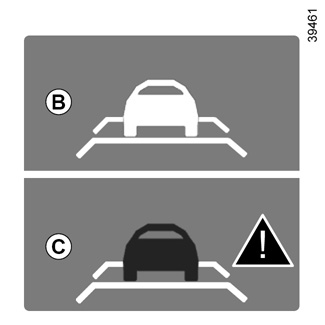
Note: if the speed previously stored is much higher than the current speed, the vehicle will accelerate to reach this threshold.
Under certain conditions (coming up behind a vehicle moving more slowly, rapid change of lane of vehicles in front etc.), the system may not have time to respond and may emit a beep alongside the alert B when the situation requires the driver’s attention, or the alert C when the situation requires immediate action from the driver.
React accordingly and perform the appropriate manoeuvres.
Please note that you must keep your feet close to the pedals in order to react in an emergency.
Putting the cruise control on standby or switching it off does not cause a rapid reduction in speed: you must brake by depressing the brake pedal.
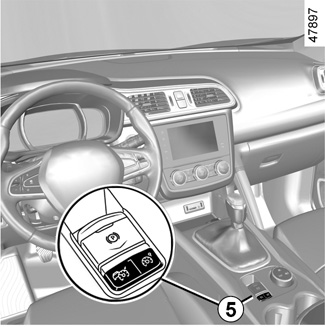
Switching off the function
The cruise control function is deactivated if you press switch 5: in this case a speed is no longer stored. The green indicator light and the message ”Adaptive cruise ctrl” on the instrument panel go out to confirm that the function is deactivated.
Operating faults
When the system detects an operating fault, the warning light lights up on the instrument panel, with the message “Check cruise control”.
There are two possibilities:
- the system is temporarily disrupted (for example: radar obscured by dirt, mud, snow etc.). In this case, park the vehicle and switch off the engine. Clean the detection zone of the radar. When you next start the engine, the warning light and the message go out;
- otherwise, this may be caused by another fault. Consult an approved dealer.
This function is an additional driving aid. This function is not under any circumstances intended to replace the due care and attention of the driver, who should at all times be in control of the vehicle.
The driver should always adapt their speed to the traffic conditions, regardless of the system indications.
The system should under no circumstances be taken to be an obstacle detector or an anti-collision system.
System servicing/repairs
- In the event of an impact, the sensor alignment may become changed, and its operation will consequently be affected. Deactivate the function, then consult an authorised dealer.
- Any work in the area where the radar is located (repairs, replacements, touching up of paintwork) must be carried out by a qualified professional.
System disturbance
In a complex environment (metal bridge, etc.), the system may be affected.
Risk of inadvertent braking.
Limitation of the system operation
- A vehicle travelling in the opposite direction will not trigger any alert or any action on the system operation.
- The sensor area should be kept clean and free of any modifications in order to ensure the proper operation of the system.
- Fixed obstacles (stationary vehicles, traffic jams, toll booths etc.) or objects travelling at low speed or of a small size (motorbikes, bicycles, pedestrians etc.) may not be detected by the system.
- A vehicle entering the same lane will only be detected once it has entered the detection zone. Sudden or late braking may then take place.
- When entering a bend or curve, the sensor may temporarily no longer detect the vehicle in front, and this may lead to acceleration.
- When exiting a curve, the detection of the vehicle in front may be affected or delayed. Sudden or late braking may then take place.
- A slower vehicle travelling in an adjacent lane may be detected and cause a slowing down if one of the two vehicles is travelling too close to the lane of the other.
- The system is deactivated below around 20 mph (40 km/h). Drivers must react accordingly.
- Sudden changes in situation are not instantly taken into account by the system. Drivers must remain vigilant at all times and under all circumstances.
Deactivating the function
You must disable the function if:
- the brake lights are not functioning;
- the front of the vehicle has undergone an impact or been damaged;
- the vehicle is being towed (breakdowns);
- traffic is heavy;
- the vehicle is travelling in a tunnel;
- the vehicle is travelling on a windy road;
- the vehicle is travelling on a slippery road or in poor weather conditions (fog, snow, rain, side winds etc.).
In the event of the system behaving abnormally, deactivate it and consult an authorised dealer.